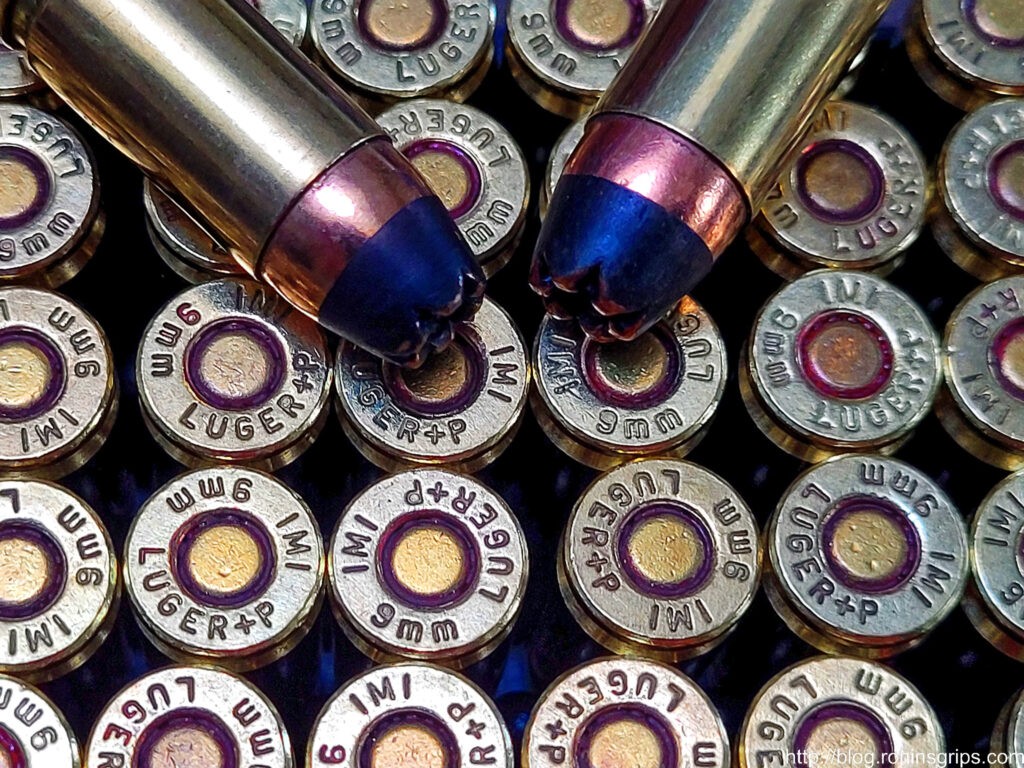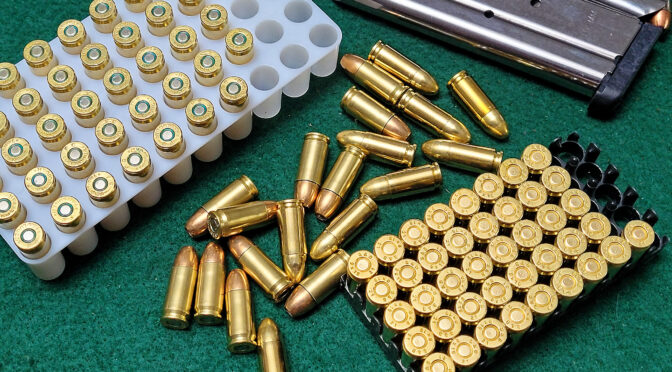Okay, let’s dive into the world of arcane ammunition industry acronyms. If you are into pistols at all, I bet you have seem ammo rated, or claimed to be, “+P” or even “+P+” and maybe you’ve encountered pistols that claim to handle the same. What does that really mean? That’s a good question and let’s review the two in the world of pistol calibers.
In the US, there is a standards group for ammunition loads called the Sporting Arms and Ammunition Manufacturers’ Institute (SAMMI). This group was formed in 1926 with the goal of safety and compatibility. Having standards allows gun manufacturers and ammo producers to have a “meeting of the minds” about what is required for a given caliber such as 9x19mm (9mm Luger or “Parabellum” — I’ll just write “9mm going forward). Without a standard, there could be safety issues as a given firearm may be not be able to handle the pressure of a given load and fail (explode). In short, standards allow us to switch between brands of ammo with a degree of safety and consistency.
| Notice how I said a degree of consistency – it’s far from perfect and many factors affect whether a given firearm will function reliably and accurately with a given round from a specific manufacturer. For example, I had a .44 Magnum Desert Eagle Mark V way back when. It could shoot just about any ammo but there was this one brand, I don’t recall who, that had an odd looking crimp in the middle of the case. My Desert Eagle absolutely could not extract that stuff. It was a brand name ammo and I am sure it worked fine in revolvers but definitely not for me in my specific pistol. In short, you always want to confirm what ammunition your firearm “likes” and include your various magazines in that testing as well. |
+P Means Higher Pressure
What “+P” refers to are standard over-pressure loads and there are actually very few of them. By over-pressure, I mean over standard pressure — +P rounds are loaded to what is called “peak pressure” and since there are a number of factors that affect peak, you can see variations in +P loads.
One consideration take into account is a degree of safety. If we make a broad generalization, if a firearm in reasonably good condition fires one, it should be okay. For example, a 9mm pistol in good shape should be able to handle 9mm+P. With that said, I need to make a safety comment:
| +P Safety Considerations 1. Only use +P ammo in a firearm that the manufacturer states can handle it either in the manual or on their website. 2. If a firearm manufacturer tells you not to then don’t. 3. Never run +P ammo in an older firearm 4. Due to the higher operating pressure, bear in mind that you will likely accelerate the wear and tear on your firearm by using this ammo. 5. It’s going to recoil more and may adversely affect recoil-sensitive people or take you longer to get back on target after firing. |
Why have +P?
The standardized +P rounds are all common defensive rounds – 9mm Luger, .38 Special, .38 Super Auto, and .45 ACP. The intent was to produce higher velocities and energy levels as a result of boosting the pressure. The following table was generated from the 2015 specification for pistol calibers Z299.3:
| Cartridge | Standard PSI | +P PSI | Increase |
|---|---|---|---|
| 9mm Luger (9×19) | 35,000 | 38,500 | +10.0% |
| .38 Special | 17,500 | 20,000 | +14.3% |
| .38 Super Auto | 26,500 | 36,500 | +37.7% |
| .45 ACP | 21,000 | 23,000 | + 9.5% |
All things being equal, by boosting the pressure, then the velocity and energy of the round go up. In short, a +P pressure load hits harder with the same bullet. That’s something that you often want in a defensive caliber but there are limits lest you have over penetration, etc. It’s also important to always point out that energy levels are not a substitute for accurate shot placement.

What if a caliber is not on the list?
If a caliber is not listed above, then you have entered the world of marketing where “+P” sells more ammo. If a manufacturer decides to use some internal rule of thumb to increase the base pressure then that is totally of their own accord. You have no idea what it is and neither do the folks who build pistols chambered for that round. For example, consider .380 ACP +P rounds you sometimes see for sale. My Ruger LCP Max points out in a number of places in the manual not to run +P ammo in their pistol because they can’t guarantee performance or safety since there isn’t a standard for Ruger to build and test against.
Note that groups who make non-standard +P ammo are quick to point out that they stay under what the “proof” loads are that are standards based and are intended to test the safety of a firearm design. Well folks, cumulative stress is cumulative stress – it builds up over time. You go running a real hot round in a real world pistol or pistol caliber carbine with a lot of real world use and it’s impossible to predict the results.
This is why I do load my defensive weapon magazines with 9mm+P but practice at the range with regular range loads. I always verify a combination of firearm, magazine and ammo load before I count on it but then I shoot the lighter stuff for practicing to reduce the wear on my pistols.
By the way, this is also why my Ruger LCP Max only had standard .380 ACP loads in it and no hotrodded ammo.
What about +P+?
Ok, now when we talk about “+P+” rounds we have completely left the SAMMI standard. You only run this ammo if you know it was made for your firearm. You should not run it on a whim without first investigating your firearm and the ammo.
| When it comes to +P+ and safety you do need to be careful. When used appropriately, it’s just fine. However, if you are thinking “oh, it’s just a few thousand PSI more – that’s not much”, I want you to remember something – a little bit doesn’t matter until it does. |
Am I anti +P+? Actually, no, I’m not. I used to encounter +P+ for 9mm sub guns with heavier mechanisms that could handle the higher pressures and heavier recoil. If you run it in a regular 9mm pistol, well, it’s hard to say what it will do – at the very least it is going to prematurely wear the pistol’s components even more than +P will.
In short, only use +P+ ammo if you know what you are doing and have done your research about using it in your particular weapon. Certainly don’t just pick it because your think it will hit harder.
Conclusion
+P and +P+ ammo have their uses and you need to make sure you read up on what your firearm, be it a pistol or pistol caliber carbine, can handle a given load before you use it. Also, one last comment – be sure to thoroughly test a combination of firearm, magazine and round before you rely on it.
References
- https://saami.org/technical-information/ansi-saami-standards/
- https://www.outdoorlife.com/guns/what-is-p-ammo/
- https://en.wikipedia.org/wiki/Overpressure_ammunition
- https://www.ammunitiontogo.com/lodge/what-is-p-ammunition/
- https://aliengearholsters.com/blog/plus-p-ammo-safe/
- https://www.nrafamily.org/content/p-ammunition-what-higher-pressure-ammo-means-to-you-1/
- https://wethepeopleholsters.com/blogs/news/9mm-p-what-is-p-ammo
- https://gunbelts.com/blog/what-you-need-to-know-about-plus-p-ammo/
Note, I have to buy all of my parts – nothing here was paid for by sponsors, etc. I do make a small amount if you click on an ad and buy something but that is it. You’re getting my real opinion on stuff.
If you find this post useful, please share the link on Facebook, with your friends, etc. Your support is much appreciated and if you have any feedback, please email me at in**@*********ps.com. Please note that for links to other websites, we are only paid if there is an affiliate program such as Avantlink, Impact, Amazon and eBay and only if you purchase something. If you’d like to directly contribute towards our continued reporting, please visit our funding page.
